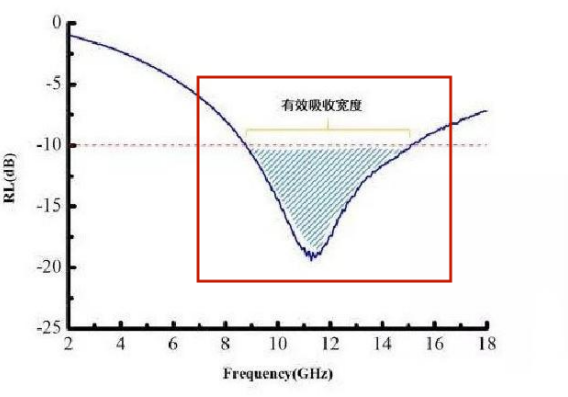Wave-absorbing materials need to meet two key points:
1.Strong electromagnetic wave absorption capability: This means the material must be able to effectively "capture" and reduce electromagnetic waves.
2.Wide frequency coverage: This indicates that the material needs to work effectively across multiple frequencies.
Specifically, we use two main indicators to measure the effectiveness of wave-absorbing materials:
1.Reflection Loss (RL)
Definition: This is an indicator that measures the material's ability to absorb electromagnetic waves at a specific frequency.
Unit: Measured in dB, the higher the value, the stronger the material's ability to absorb electromagnetic waves.
2.Effective Absorption Bandwidth:
Definition: This refers to the frequency range over which the material can achieve the specified absorption rate.
Condition: Typically, when the reflection loss (RL) is below -10 dB, the material can achieve about 90% absorption at that frequency.
Unit: Measured in GHz, the higher the value, the broader the material's effective absorption frequency range.

Figure 1 shows a typical performance curve of wave-absorbing material. The vertical axis (y-axis) represents the reflection loss (RL), and the horizontal axis (x-axis) represents the frequency. The curve on this graph illustrates how the reflection loss of the wave-absorbing material changes with frequency at a fixed thickness.
Relationship between absorption performance and curve position:
If the curve is lower (i.e., the RL value is smaller), it means the material has better absorption performance. A smaller RL value indicates the material's stronger ability to absorb electromagnetic waves.
Relationship between absorption performance and the area under the curve:
Assuming the required absorption rate is -10dB, we can assess the absorption performance by observing the area between the curve and the -10 dB line (the shaded area in the figure). The larger this area, the more effectively the material absorbs electromagnetic waves across a wider frequency range.
Effective absorption bandwidth frequency range:
Typically, the best absorption effect (absorption peak) of wave-absorbing material occurs in the high-frequency range. This means that if the effective absorption bandwidth of a material is mainly concentrated in the high-frequency range, it is more suitable for electromagnetic wave absorption in high-frequency environments.
Feihongda wave-absorbing materials can match the appropriate wave-absorbing materials based on customers' different frequency requirements.
For more detailed information, please contact our customer service through the official website~





